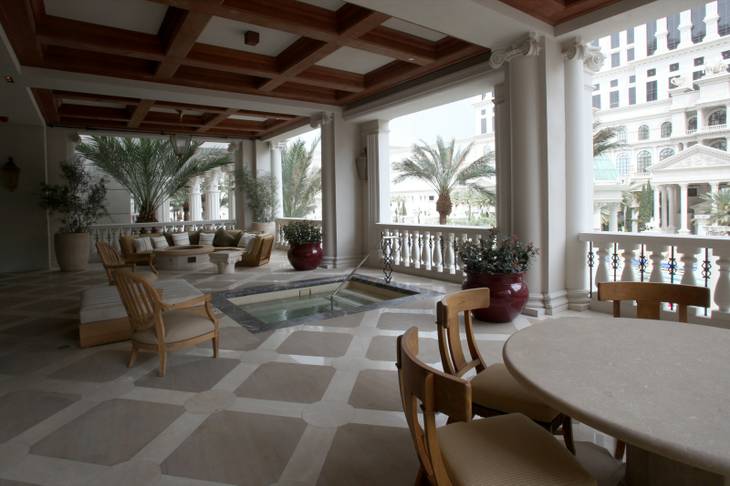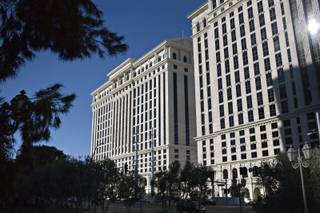Map of Caesars Palace
When Caesars Entertainment halted construction on a sixth hotel tower at Caesars Palace in 2009, the company said it would only revive the project once business in Las Vegas recovered. Last month’s announcement that Caesars will finish the Octavius tower for a January debut prompts the question: Did the Las Vegas economy get its groove back?
Recovery is in the eye of the beholder.
Earnings on the Strip have improved somewhat, narrowing losses for casino giants like Caesars that are still in the red. Rising room rates, gambling revenue and visitor volume have offset slightly the exorbitant cost of pre-recession projects and the hundreds of millions, if not billions, in debt held by its biggest operators, however.
Caesars’ decision to press forward with additional hotel rooms is a calculated bet on the future rather than present. Executives say it reflects an upward trend in Las Vegas, especially greater spending among higher-profit customers such as conventions and high-rolling gamblers who have led the recovery on the Strip.
Caesars has reported higher room rates and occupancy this year, including increased convention bookings — a trend executives expect will continue through the end of the year.
“Our business is strengthening, with noted growth in the Las Vegas market,” Caesars Entertainment CFO Jonathan Halkyard said in a conference call last month.
Although fewer customers are visiting Caesars-owned casinos than before the recession, the remaining customers are spending more per trip than they were a year ago, Halkyard said.
MGM Resorts International, Wynn Resorts and Las Vegas Sands have benefited from increased business among those who still have discretionary dollars to spread around, especially convention-goers and big gamblers.
The convention and high-roller business may be reason enough to reboot the tower project, according to some Las Vegas watchers.
“I agree that those are two segments that have done better than others this year,” said Jacob Oberman, director of gaming research and analysis at CB Richard Ellis. “They wouldn’t be doing this if they thought business was falling off a cliff.”
Business among small and medium-size groups, from corporate executives to girlfriends in town for bachelorette parties, is growing for the company in Las Vegas, Caesars Entertainment spokesman Gary Thompson said.
The deluxe accommodations also are suited to high-rollers such as the Asian gamblers who are fueling growth in baccarat on the Strip, he added.
“The high-net-worth customer is not following the overall trend of reduced spending,” he said.
In addition to the handful of luxury villas that are part of the Octavius tower, Caesars also is expanding its high-limit gambling pit by building four private gambling salons.
Other projects that were halted in the downturn, including the unbuilt Plaza Las Vegas, a version of CityCenter planned for Sahara Avenue and Las Vegas Boulevard, the mostly constructed Fontainebleau and Echelon Place, a steel skeleton, were entirely new resorts built from scratch.
Octavius is shoehorned into an already-busy resort, the flagship of its parent company and a property that receives the bulk of the company’s high-net-worth customers. After Octavius, Caesars will have just over 4,000 rooms — making it one of the largest resorts in the city.
When it opened in 2005, Caesars’ Augustus tower became a big draw for the company primarily because its offerings appealed to bigger spenders. Even big spenders tightened up in the recession, but they haven’t been as hard hit as middle-class customers — a trend reflected in the fact that luxury hotels in Las Vegas and beyond have generally outperformed the budget category.
Caesars lined up some of the money for Octavius before the market tumbled. To finish the tower, as well as build a separate entertainment attraction called Linq across the Strip, Caesars secured a $450 million term loan maturing in six years, secured by Caesars’ assets. The bank deal requires Caesars to guarantee completion of the tower and meet certain performance requirements.
Still, Caesars is tiptoeing around billions of dollars in corporate debt. Over the past year, the company trimmed that debt from $23.3 billion to about $22.5 billion as of June 30. Caesars has saved hundreds of millions of dollars by negotiating more favorable terms with lenders as well as reducing corporate overhead.
Although the company is still reporting net losses, earnings before items such as interest and taxes have grown in the wake of cost cuts on top of improving business. But incremental improvements may not help the company stave off default in the absence of a more significant improvement in the economy and the ability of ordinary Americans to spend money, analysts have noted.
Where others are falling behind in the poor economy, Caesars says it is doing better than staying afloat with the help of the company’s Total Rewards loyalty program, which is gearing up to offer personalized benefits for regular gamblers and not just the biggest players. Caesars typically comps or discounts its Las Vegas rooms for gamblers, achieving high occupancy by virtue of those gamblers who spend money at the company’s smaller casinos throughout the country.
With amenities such as marble floors, granite desks, velvet sofas, and bathrooms with flat-screen TVs and oversized whirlpool tubs, the Octavius tower doesn’t seem the right fit for the majority of Las Vegas travelers now seeking big bargains.

